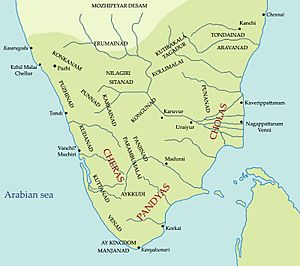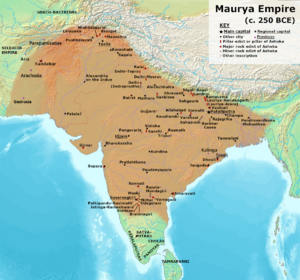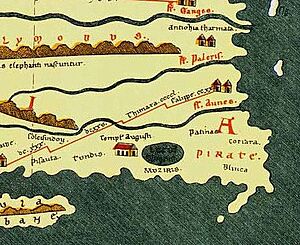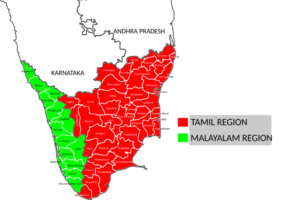Tamilakam facts for kids
Tamilakam (Tamil: தமிழகம், romanized: Tamiḻakam) was an ancient land in the southern part of the Indian subcontinent. It was home to the ancient Tamil people. Today, this area includes Tamil Nadu, Kerala, Puducherry, Lakshadweep, and parts of southern Andhra Pradesh and Karnataka.


Ancient stories and a very old book called the Tolkāppiyam describe Tamilakam as one big cultural area. Here, Tamil was the main language, and it shaped the way everyone lived. This ancient land was divided into different kingdoms. The most famous ones were the Cheras, Cholas, Pandyans, and Pallavas. During the Sangam period, Tamil culture started to spread beyond Tamilakam. Ancient Tamil groups also settled in Sri Lanka (Sri Lankan Tamils) and the Maldives (Giravarus) a long time ago.
For many centuries, from ancient times to the early modern age, the powerful empires from northern India, like the Maurya Empire and the Mughal Empire, could not conquer Tamilakam.
Today, politicians in India sometimes use the name Tamilakam to talk only about the state of Tamil Nadu.
Contents
What Does Tamilakam Mean?
The word "Tamiḻakam" comes from the Tamil language. It combines Tamiḻ (Tamil) and -akam (home). So, it roughly means "the home of Tamil." Experts like Kamil Zvelebil believe this is the oldest name for the Tamil land in India.
Ancient Roman writings, like the Periplus of the Erythraean Sea and Ptolemy's books, mention a place called "Limyrike." This name likely referred to the Malabar Coast in southwest India. Another Roman map, the Tabula Peutingeriana, shows a place called "Damirica." Some scholars thought "Damirica" was the same as "Limyrike" and "Tamilakam" because it sounded similar. However, the "Damirice" on that map actually points to an area far north, between the Himalayas and the Ganges River.
Where Was Tamilakam Located?
The term "Tamilakam" is very old. It appears in ancient Tamil poems like Purananuru and Patiṟṟuppattu. An older text, the Tolkāppiyam, also talks about "the beautiful world where Tamil is spoken."
According to the Tolkāppiyam, the land where Tamil was the main language stretched from the northern Venkata hill (which is now called Tirupati) down to the southern Kumari (Cape Comorin).
The Silappadikaram, a famous Tamil epic from around the 2nd century CE, describes Tamilakam like this:
The Tamil region extends from the hills of Vishnu [Tirupati] in the north to the oceans at the cape in the south. In this region of cool waters were the four great cities of: Madurai with its towers; Uraiyur which was famous; tumultuous Kanchi; and Puhar with the roaring waters [of the Kaveri and the ocean].
These old texts don't clearly mention the eastern and western borders. But historians believe these were the seas. So, ancient Tamilakam included modern-day Kerala. However, it did not include the Tamil-speaking areas in the North-East of Sri Lanka.
Kingdoms and Regions of Tamilakam
Main Kingdoms
From about 600 BCE to 300 CE, Tamilakam was mostly ruled by three powerful Tamil families: the Chola dynasty, the Pandyan dynasty, and the Chera dynasty. There were also some smaller independent rulers called the Velirs. The earliest records of these Tamil kingdoms come from inscriptions made around the 3rd century BCE, during the time of the Maurya Empire.
- The Chola dynasty ruled from before the Sangam period (around 3rd century BCE) until the 13th century. Their main area was the rich Kaveri river valley in central Tamil Nadu.
- The Pandyan dynasty ruled parts of South India until the late 17th century. Their main area was the fertile Vaigai River valley. They first ruled from Korkai, a port city at the southern tip of India, and later moved to Madurai.
- The Chera dynasty ruled from before the Sangam period until the 12th century. Their kingdom covered what is now western Tamil Nadu and Kerala.
The Velirs were important local kings and chiefs in Tamilakam during this early period.
Regions within Tamilakam
Tamilakam was divided into large political areas called Perunadu, meaning "Great country."
There were three main Perunadus: Chera Nadu, Chola Nadu, and Pandya Nadu. Over time, two other regions, Athiyaman Nadu and Thamirabharani Nadu, became part of Chera and Pandya Nadu. Tondai Nadu, which was part of Chola Nadu, later became the independent Pallava Nadu around the 6th century CE.
Tamilakam was also split into 13 smaller regions, each called a Nadu (country). Each of these had its own way of speaking Tamil.
- Thenpandi Nadu
- Panri Nadu
- Kuda Nadu
- Punal Nadu
- Puzhi Nadu
- Venadu
- Aruva Nadu
- Kakkanadu
- Kuttanadu
- Aruva Vadathalai Nadu
- Sida Nadu
- Erumai Nadu
- Malai Nadu
- Tulu Nadu
Even though Tamilakam was divided into many kingdoms, the people living there shared a common culture and identity. They saw themselves as different from their neighbors. Ancient Tamil writings, from the 5th century BCE to the 3rd century CE, show that Tamilakam had its own unique language. Even non-Tamil kings like Ashoka and Kharavela mentioned Tamilakam as a distinct region. For example, Ashoka's inscriptions talk about independent states south of his kingdom. Kharavela's inscription mentions defeating a "confederacy of Tamil powers."
Connection with Sri Lanka
Between 1000 and 500 BCE, Sri Lanka and southern India shared a similar culture. They had similar burial sites, pottery, iron tools, farming methods, and symbols. This culture spread from southern India with groups like the Velir, even before people speaking Prakrit (another ancient Indian language) arrived.
An ancient seal found in Sri Lanka, called the Annaicoddai seal (from the 3rd century BCE), has writing in both Tamil and Brahmi scripts. This shows early connections. Also, coins found in southern Sri Lanka, made between the 2nd century BCE and 2nd century CE, have Tamil names written on them. This suggests that Tamil traders were active in Sri Lanka's southern coast during that time.
Around 237 BCE, "two adventurers from southern India" took control of the Anuradhapura kingdom in Sri Lanka. Later, in 145 BCE, a Chola general or prince named Ellāḷaṉ ruled at Anuradhapura for 44 years. A Sinhalese king named Dutugamunu fought and defeated him. Tamil kings have been recorded in Sri Lanka since at least the 3rd century BCE.
Religions in Tamilakam
Different religions have lived side-by-side in the Tamil country since at least the 2nd century BCE. These include Hinduism (with its different branches like Vaishnavism, Kaumaram, Shaktism, and Shaivism), Dravidian folk religion, Jainism, and Buddhism.
|
See Also
- Sources of ancient Tamil history
- Chronology of Tamil history
- History of Tamil Nadu
- History of Kerala



